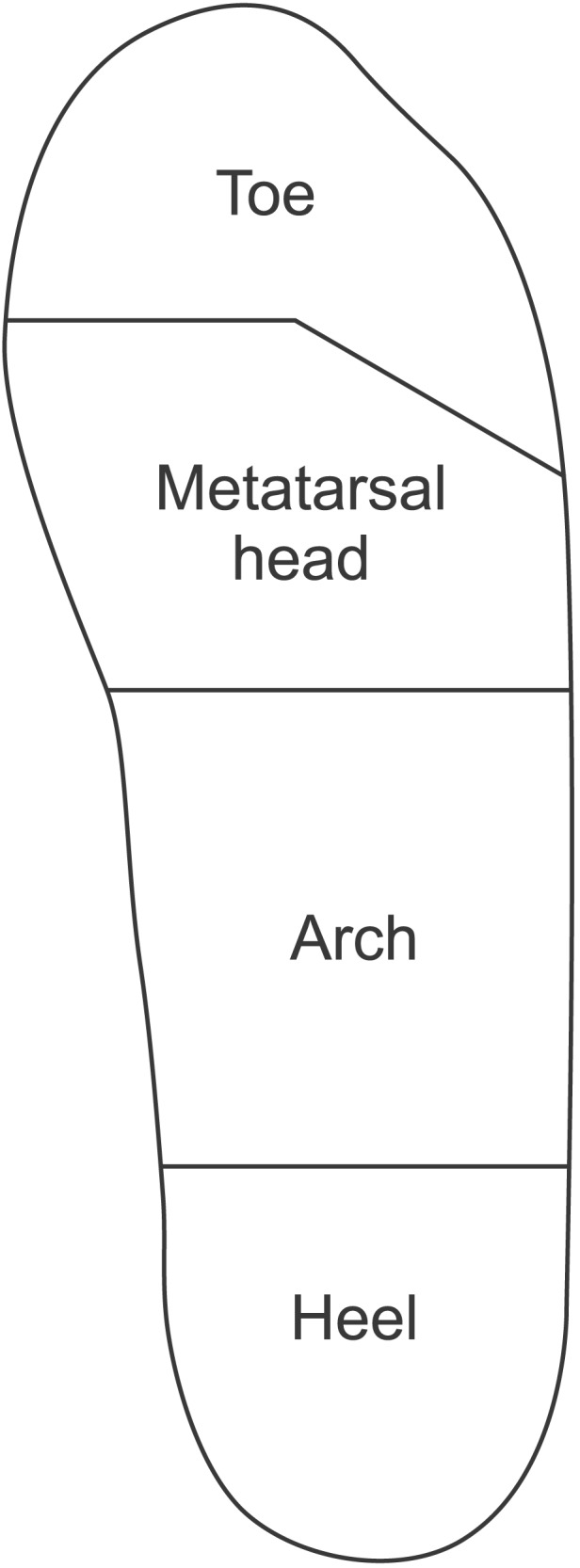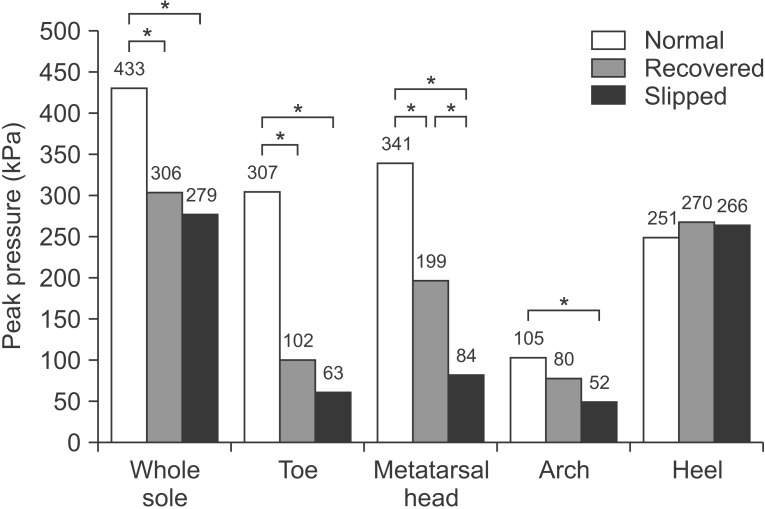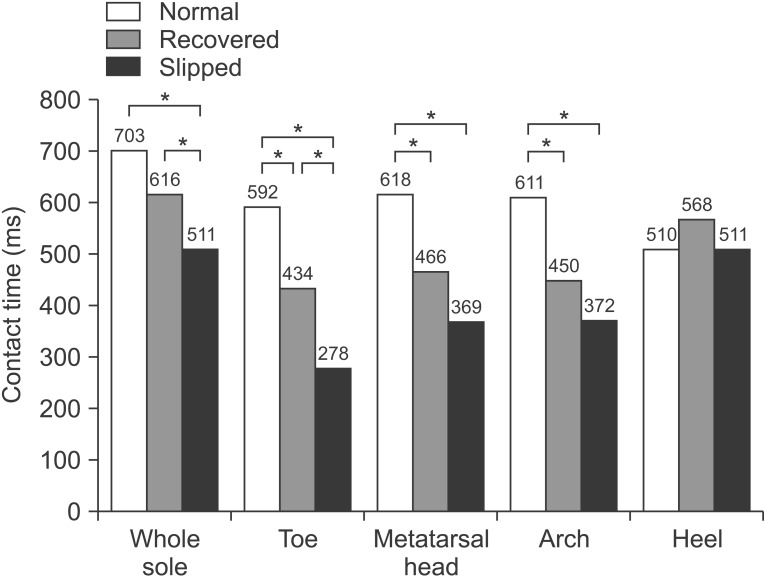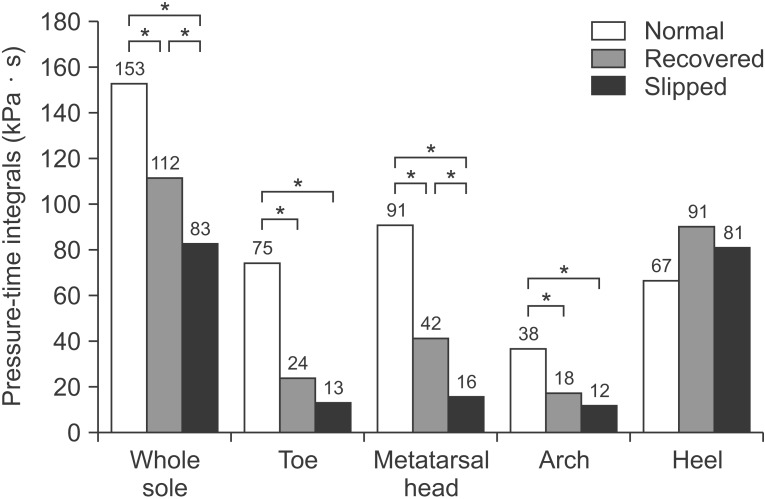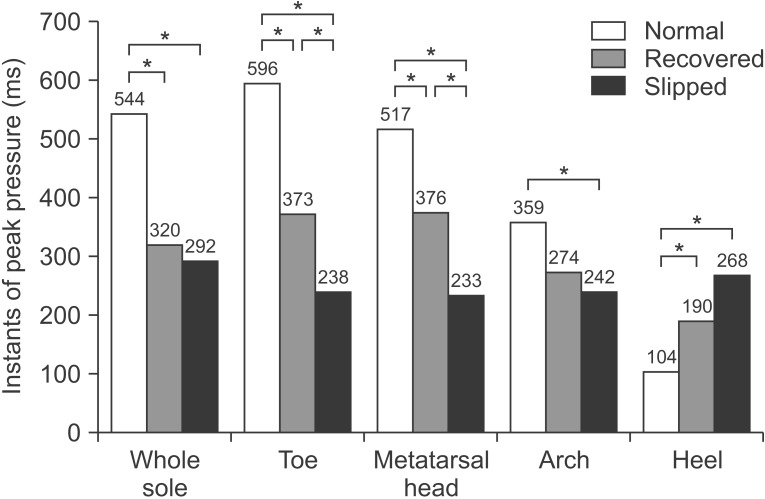Ann Rehabil Med.
2015 Dec;39(6):897-904. 10.5535/arm.2015.39.6.897.
Slip-Related Changes in Plantar Pressure Distribution, and Parameters for Early Detection of Slip Events
- Affiliations
-
- 1Department of Rehabilitation Medicine, Hanyang University College of Medicine, Seoul, Korea.
- 2Department of Rehabilitation Medicine, Hanyang University Guri Hospital, Hanyang University College of Medicine, Guri, Korea. systole77@hanmail.net
- KMID: 2165615
- DOI: http://doi.org/10.5535/arm.2015.39.6.897
Abstract
OBJECTIVE
To investigate differences in plantar pressure distribution between a normal gait and unpredictable slip events to predict the initiation of the slipping process.
METHODS
Eleven male participants were enrolled. Subjects walked onto a wooden tile, and two layers of oily vinyl sheet were placed on the expected spot of the 4th step to induce a slip. An insole pressure-measuring system was used to monitor plantar pressure distribution. This system measured plantar pressure in four regions (the toes, metatarsal head, arch, and heel) for three events: the step during normal gait; the recovered step, when the subject recovered from a slip; and the uncorrected, harmful slipped step. Four variables were analyzed: peak pressure (PP), contact time (CT), the pressure-time integral (PTI), and the instant of peak pressure (IPP).
RESULTS
The plantar pressure pattern in the heel was unique, as compared with other parts of the sole. In the heel, PP, CT, and PTI values were high in slipped and recovered steps compared with normal steps. The IPP differed markedly among the three steps. The IPPs in the heel for the three events were, in descending order (from latest to earliest), slipped, recovered, and normal steps, whereas in the other regions the order was normal, recovered, and slipped steps. Finally, the metatarsal head-to-heel IPP ratios for the normal, recovered, and slipped steps were 6.1+/-2.9, 3.1+/-3.0, and 2.2+/-2.5, respectively.
CONCLUSION
A distinctive plantar pressure pattern in the heel might be useful for early detection of a slip event to prevent slip-related injuries.
Keyword
Figure
Reference
-
1. Layne LA, Pollack KM. Nonfatal occupational injuries from slips, trips, and falls among older workers treated in hospital emergency departments, United States 1998. Am J Ind Med. 2004; 46:32–41. PMID: 15202123.
Article2. Courtney TK, Matz S, Webster BS. Disabling occupational injury in the US construction industry, 1996. J Occup Environ Med. 2002; 44:1161–1168. PMID: 12500458.
Article3. Jensen OC, Sorensen JF, Canals ML, Hu Y, Nikolic N, Mozer AA. Non-fatal occupational injuries related to slips, trips and falls in seafaring. Am J Ind Med. 2005; 47:161–171. PMID: 15662643.
Article4. Lincoln AE, Sorock GS, Courtney TK, Wellman HM, Smith GS, Amoroso PJ. Using narrative text and coded data to develop hazard scenarios for occupational injury interventions. Inj Prev. 2004; 10:249–254. PMID: 15314055.
Article5. Lipscomb HJ, Glazner J, Bondy J, Lezotte D, Guarini K. Analysis of text from injury reports improves understanding of construction falls. J Occup Environ Med. 2004; 46:1166–1173. PMID: 15534504.
Article6. Dempsey PG, Filiaggi AJ. Cross-sectional investigation of task demands and musculoskeletal discomfort among restaurant wait staff. Ergonomics. 2006; 49:93–106. PMID: 16393806.
Article7. Mitchell R, Curtis K, Watson WL, Nau T. Age differences in fall-related injury hospitalisations and trauma presentations. Australas J Ageing. 2010; 29:117–125. PMID: 20815841.
Article8. Courtney TK, Sorock GS, Manning DP, Collins JW, Holbein-Jenny MA. Occupational slip, trip, and fall-related injuries: can the contribution of slipperiness be isolated? Ergonomics. 2001; 44:1118–1137. PMID: 11794761.
Article9. Hanson JP, Redfern MS, Mazumdar M. Predicting slips and falls considering required and available friction. Ergonomics. 1999; 42:1619–1633. PMID: 10643404.
Article10. Fong DT, Mao DW, Li JX, Hong Y. Greater toe grip and gentler heel strike are the strategies to adapt to slippery surface. J Biomech. 2008; 41:838–844. PMID: 18068710.
Article11. Mcllroy WE, Maki BE. Adaptive changes to compensatory stepping responses. Gait Posture. 1995; 3:43–50.
Article12. Cham R, Redfern MS. Lower extremity corrective reactions to slip events. J Biomech. 2001; 34:1439–1445. PMID: 11672718.
Article13. Chambers AJ, Cham R. Slip-related muscle activation patterns in the stance leg during walking. Gait Posture. 2007; 25:565–572. PMID: 16876417.
Article14. Nyan MN, Tay FE, Mah MZ. Application of motion analysis system in pre-impact fall detection. J Biomech. 2008; 41:2297–2304. PMID: 18589428.
Article15. Foroughi H, Naseri A, Saberi A, Yazdi HS. An eigenspace-based approach for human fall detection using integrated time motion image and neural network. In : Proceedings of 9th International Conference on Signal Processing; 2008 Oct 26-29; Beijing, China. p. 1499–1503.16. Lai CF, Chang SY, Chao HC, Huang YM. Detection of cognitive injured body region using multiple triaxial accelerometers for elderly falling. IEEE Sens J. 2011; 11:763–770.
Article17. Shi G, Zou Y, Jin Y, Li WJ. PCA/ICA-based SVM for fall recognition using MEMS motion sensing data. In : Proceedings of IEEE Asia Pacific Conference on Circuits and Systems; 2008 Nov 30-Dec 3; Macao, China. p. 69–72.18. Kernozek TW, LaMott EE, Dancisak MJ. Reliability of an in-shoe pressure measurement system during treadmill walking. Foot Ankle Int. 1996; 17:204–209. PMID: 8696496.
Article19. Quesada P, Rash G, Jarboe N. Assessment of pedar and F-Scan revisited. Clin Biomech (Bristol, Avon). 1997; 12:S15.
Article20. Putti AB, Arnold GP, Cochrane L, Abboud RJ. The Pedar in-shoe system: repeatability and normal pressure values. Gait Posture. 2007; 25:401–405. PMID: 16828288.
Article21. Moyer BE, Chambers AJ, Redfern MS, Cham R. Gait parameters as predictors of slip severity in younger and older adults. Ergonomics. 2006; 49:329–343. PMID: 16690563.
Article22. Shi G, Chan CS, Li WJ, Leung KS, Zou Y, Jin Y. Mobile human airbag system for fall protection using MEMS sensors and embedded SVM classifier. IEEE Sens J. 2009; 9:495–503.
Article23. Yavuz G, Kocak M, Ergun G, Alemdar HO, Yalcin H, Incel OD, et al. A smartphone based fall detector with online location support. In : Proceedings of International Workshop on Sensing for App Phones; 2010 Nov 2; Zurich, Switzerland. p. 31–35.
- Full Text Links
- Actions
-
Cited
- CITED
-
- Close
- Share
- Similar articles
-
- Correlation of Pelvic Parameters with Isthmic Spondylolisthesis
- Anatomical variation of quadratus plantae with flexor digitorum longus tendon along with unilateral polydactyly of the toes: a rare case report
- The Tendinous Slip of the Flexor Digitorum Longus for the Great Toe: An Anatomic Variation
- Penetrating Injury by an Iron Reinforcing Bar Associated with a Fall or Slip Injury
- Laboratory Information System using One Combined Request Slip: Specimen Requisition and Order Input System

